How To Fix Over Filed Nails
Y'all are here: Domicile / Building / Laying chipboard flooring
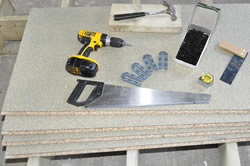
Tools required
Chipboard flooring with tongue and groove joints is unremarkably bachelor for flooring applications. They are relatively cheap and quick to lay. Standard size sheets are 2400mm x 600mm and available in two thicknesses – 18mm and 22mm. The tongue and groove edges make for a stiff bond between the boards. Water resistant flooring grade chipboard should be used. Ordinary chipboard is easily damaged by moisture which causes it to swell and intermission upward.
The chipboard flooring sheets should be stored flat in the room for a couple of days earlier laying them to permit them to acclimatise to differences in temperature and humidity. Whilst chipboard flooring can be nailed, information technology is notorious for working loose and squeaking so screwing them downwardly is the preferred method of fixing and really doesn't take long using a decent cordless driver.
Expansion gaps should exist left around the perimeter of the flooring to allow for temperature and humidity changes. With suspended timber ground floors, expanding foam can be used effectually the edges to stop any draughts. The surface of chipboard is very polish and this tin can make them slippery when treatment. A useful tip is to habiliment decent work gloves which give better grip.
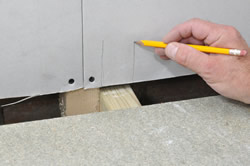
1. Mark positions
Mark the position of the joists along the bottom edge of the walls. This volition make information technology easier to marking the boards and align the screws with the joists.
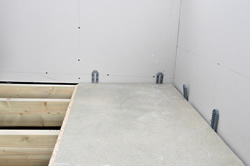
2. Lay boards lengthways
2. Boards are laid lengthways across the joists and 'printed side' up. Loose lay the kickoff board so that its grooved side is towards the wall. Align it so that it is square with the joists and leave a 10mm gap along the wall edge to allow for expansion. In some situations, the boards confronting the wall will demand to be cut in afterwards – see additional info beneath.
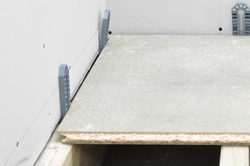
3. Apply plastic shims
Utilise plastic shims or suitably sized timber wedges to maintain the expansion gap. This gap volition exist subconscious when the skirting boards are fixed. Button the board tight against these shims whilst still maintaining alignment.
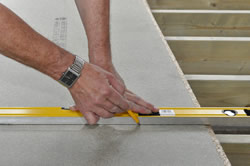
4. Mark centre line of joists
Employ a steel straight border to marking out the centre line of the joists. Align i end with the marks fabricated earlier at the base of operations of the wall, and the other with the heart of the exposed joist. Mark out the screw positions along these lines. These should be at 150mm centres forth the joists and, the border fixings should be no closer than 10mm to the lath edge.
5. Use pointed lath screws
Using sharp pointed board screws will mean that y'all do not need to drill pilot holes kickoff. Some of the best quality board screws are lubricated which allows them to drive quickly and easily through the chipboard.
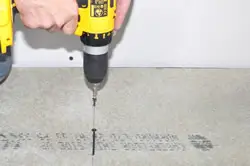
vi. Check board alignment
Double check the alignment of the board before fixing. Starting at one end of the board, drive in the screws with a cordless commuter. Set up the torque so that the screws countersink themselves into the surface – but only just. Work your manner along the board fixing across each joist as you go.
seven. Continue lengthways from first board
vii. With the commencement board in place proceed lengthways. Loose lay the next lath butting the terminate of the previous one. Carefully marshal so that it continues to be square with the joists and insert shims along the wall edge to maintain the 10mm expansion gap.
8. Avoid flying joints
It is preferable to have the end natural language and groove joint sitting over the centre of a joist. Yet, this is not always practical especially if the joist centres vary. Many people say that a 'flying joint' with tongue and groove boards is perfectly OK. If it is not practical to have cease joints over joists, noggins tin be screwed in position between the joists to give extra back up.
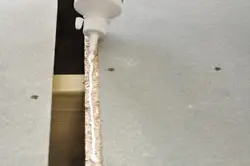
9. Utilise wood mucilage to natural language
Slide the loose laid lath away from the previously stock-still board and apply a bead of wood gum along the natural language of the showtime board. Push the board dorsum into position so that the joint is proficient and tight. You tin can utilise a wooden chock and hammer to tighten if needs be. Wipe away any excess glue and marking and prepare the board every bit before.
10. Cut final board to length
The final lath of the first row volition need to be cutting to length. Measure from the cease of the terminal board to the wall and deduct 10mm. Brand sure the measurement is taken from the top edge not the edge of the tongue. Measure this gap on both sides of the board as the end wall may not exist square.
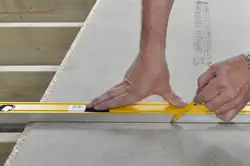
11. Mark the cut line with directly edge
11. Lay a new sheet of chipboard on a suitable bench or support and use the measurements to mark the face of the board on either edge. Employ a straight edge and pencil to mark the cut line.
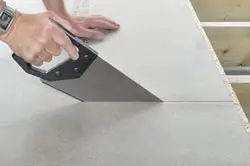
12. Cut from upper side of board
Use a hand saw to cutting along the outer edge of this line. Keep the saw direct and foursquare as you go and apply long clean strokes. Cutting from the upper side of the board will leave a make clean cut on this face up.
xiii. Run gum along the tongue
Run a bead of glue along the tongue of the end of the previous board. Hold the newly cut lath at an angle and line up the tongue and groove joint. Ease the board down to close the joint. Put packing shims along the edge to maintain the expansion joint. To tighten this board before fixing, tap wedges in at the end of the lath. Spiral down the board.
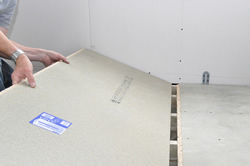
14. First second row
You lot tin can now start the 2d row. Assuming the off cut from the final lath is greater than 500mm, you can use this piece. Foursquare it off offset if needs be. Check that the stop volition align with a joist. If non, either trim the cut cease to accommodate or fit support noggins between the joists to align with the end.
15. Stagger end joints brick fashion
The end joints should be staggered in a brick way. Using the off cut from the previous row will help with this and minimise waste material.
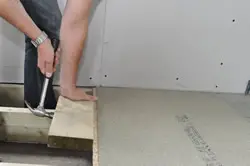
16. Gum natural language of previous row
Run a bead of forest gum along the corresponding section of the long edge tongue of the previous row and slide the board into position. Utilize a hammer and woods chock to tighten up the joint. Mark the fixings and screw the board to the joists.
17. Continue this process
Keep this process until you attain the terminal row to be fitted. Measure out the gap between the elevation edge of the terminal row and the wall at 600mm centres. Deduct 10mm from these and mark them on the lath to be cut. Measuring at 600mm centres will let for whatsoever discrepancy in the line of the wall.
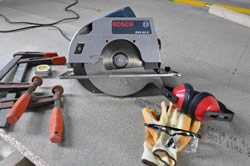
eighteen. Bring together marks with pencil
Join these marks with a pencil and cutting along the outer edge of the line. Long cuts like these are a lot easier to exercise with a circular saw. To set this up, take a notation of the distance between the edge of the saw base and the blade. Clamp a timber batten as a saw guide to the board to conform this offset.
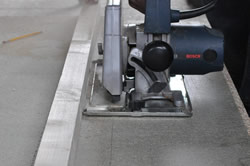
19. Clench board to workbench for cutting
The board should also be clamped firmly to the workbench so that it volition not movement equally you cut. Cheque the underside of the cut line is clear and have an assistant support the off cut as you lot reach the end of the cutting. Wearing ear defenders and safety goggles, cut along the board keeping the power string well out of the mode. Rubber gear should as well be worn past anyone else working with you.
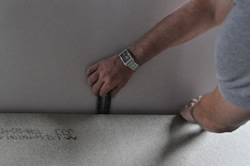
20. Bank check lath fits correctly
Bank check that the cut board fits correctly. Run a bead of glue along the respective section of tongue on the previous row. Align the new board, holding it upward at an angle. Gradually lower information technology into position and tighten the articulation using the wedges or plastic shims.
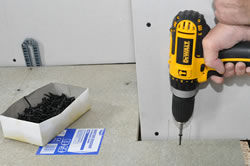
21. Recess cutting
You may have sections of board which need to be cut with a recess or pace in the wall. To do this, carefully measure the profile required, and transfer this to the board. If angles are out of square, you can make a elementary cardboard template first.
Additional info
- Measure the width of the room and split up by 600mm to establish the width of the last row of boards. If this will be less than 150mm, you should shift your rows of boards then that you cease upward with a more substantial width for the concluding row. This will mean that you have a cutting row along both sides of the room but each will exist greater than 150mm. Both these cut rows should be fitted after the main section of flooring has been fixed.
- If the side walls are significantly out of square you volition need to scribe in the showtime row and last row. In this example, you lot should besides exercise this after the primary area has been laid.
- To scribe in the boards, lay the board to be cut direct over the next row. Using a 590mm (600mm less 10mm expansion gap) crossbar with a pencil held against the end, run this along the wall carefully maintaining it at right angles. This will produce a pencil line forth with the lath accurately replicating the contour of the wall. Unless the line is straight, you lot will demand to utilize a jigsaw to cutting the board forth this profile.
- Before starting to lay the chipboard flooring on old joists, clean up the top surfaces past removing old screws and nails. It's important to brand sure the boards can sit down flat on the top of the joists
- As you lot lay boards, make a annotation of the position of any pipes and cable running under the floor. This volition assistance to make sure you don't accidentally prepare into them and will also let future owners know their location.
- Choice of thickness for the boards will depend on the spacing of your flooring joists. If they are spaced at 450mm or less, you can utilise 18mm boards. If the spacing is greater than 450mm, use 22mm thick boards.
- Provided you don't anticipate having to lift the flooring again, glue the joints to make them even stronger. Some manufacturers fifty-fifty recommend applying glue to the top of the joists as well in an endeavor to reduce movement and squeaking oft associated with chipboard floors.
- The screws used should ideally penetrate the joists by i.five x the thickness of the board. And so, with 18mm chipboard, you want board screws at least 45mm long.
- Stagger the joints by a minimum of 500mm. The tongue and groove connection between boards means that the ends needn't align with the joists, however, many people prefer to include noggins at this point to provide boosted back up.
Reader Interactions
Source: https://www.diyfixit.co.uk/laying-chipboard-flooring/
Posted by: lambertanable.blogspot.com


0 Response to "How To Fix Over Filed Nails"
Post a Comment